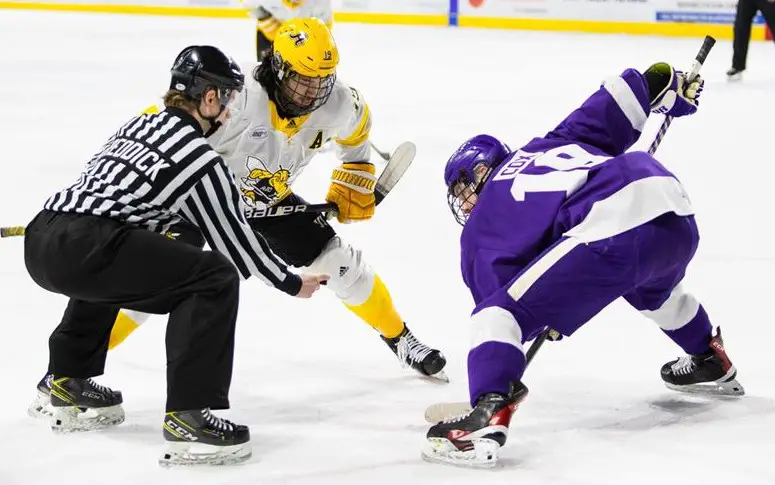
Each week during the season, we look at the big events and big games around Division I men’s college hockey in Tuesday Morning Quarterback.
Dan: Well, everyone, we finally made it, and we’re here.
March.
The glorious month when the games start counting for real, and the postseason starts. No better way to ring it in, in my opinion, than with my co-host for this week, Paula Weston.
A couple of quick hit thoughts here.
I’ve heard a number of people say that over the years, that this is the “real season.” I’ve absolutely said it myself. The more I think about it, though, the more I think that the statement somehow invalidates the last few months of hockey, and the playoffs only exist because of how teams played over the course of the entire season. Somehow, whether we realize it or not, a game in October adds pieces to why we care so much or how we perceive the games in March, and I’m glad more and more coaches are talking about those games when the year begins.
The second thought is more about postseason hockey on the whole. I have been vocal about my conflicted feelings about the 3-on-3 overtime and shootouts in general, but I’m glad that when the playoffs roll around, we settle things the way it oughta be settled: five-aside until someone scores a goal. I can’t wait for that first game to go deep into the night.
Paula, how are you feeling this week? The postseason is back, and with it, I’m sure, can you offer your thoughts on what we might see when things kick off this weekend?
Paula: Dan, the two thoughts you have there are worth addressing before we get to your question. (Short answer: I’m good. You?)
As I told Jimmy Connelly last week, I love conference playoff hockey. To me as a fan of the game, a conference championship is every bit as exciting as the national championship. We know that winning the conference is often the first stated goal of contending teams at the start of every season, and there are plenty of good reasons for that. One of the reasons is what you mentioned, that every game in October counts – and the season is so freaking long that it’s important for teams to maintain a focus. What better way to do that than to concentrate on winning the games against a finite number of known conference foes?
Another reason to love the conference championship – and to value the entire season that comes before it – is the relatively small pool of D-I programs and the big differences from conference to conference. College hockey is still a sport of the haves and have nots. There is a small number of programs that can maintain success annually, and the teams in that number change from time to time. And there are conferences that are consistently haves while others are challenged to rise to that consistent level of successful competition. The conference championship is a payoff for a long, hard-fought season playing mostly against teams that are peers. Winning a conference championship is a reward for a lot of guys who may never get the chance to compete for a national championship.
And every championship game is exciting, which is in itself a reward for everyone.
As for postseason hockey, I can’t wait until every conference gets there. Both Hockey East and the NCHC still have another week of regular-season hockey. While it’s likely that Massachusetts and North Dakota will hold onto the top spots of their respective leagues, that’s by no means a lock.
Even though I love to watch the conference championships for their own glorious sakes, it’s impossible to ignore the PairWise implications as March begins. Look at the very, very good teams on the bubble, both above and below the PWR cutoff line: Ohio State, Northeastern, UMass Lowell, Boston University, Clarkson, Providence, Merrimack. Northeastern and Merrimack are tied for second place in Hockey East and there is a possibility that one or both of them will sit out the NCAA tournament.
With all of the conference tournaments, I’m curious to see how recent momentum vs. seeding will play out, too.
What are you keeping an eye on as the postseason begins?
Dan: A return to normalcy…
No, but seriously, I can’t believe it’s been three years since conference tournaments played out under their standard formats.
Take both Atlantic Hockey and ECAC.
Atlantic Hockey played a pod-based format last year and didn’t experience a single crossover between the west and east until the single-elimination semifinal round. Air Force traveled to play Bentley, but Air Force wasn’t tied to any one particular pod because its geographic location was such an anomaly in comparison. Then Bentley, after beating Air Force, had its season ended by COVID-19, so AIC, the eventual league champion, didn’t play its first postseason game until it played Niagara in the semifinals.
This year alone, teams that didn’t see each other at all last year are scheduled to play in three different postseason series, including both this weekend when Bentley heads to Niagara and Mercyhurst hosts Holy Cross. Oh, and the fourth series is Air Force at Army, in case we needed any more intrigue to a playoff that saw anything other than a No. 1 seed win over a six-year span in a league that will send a single team to the postseason.
ECAC, meanwhile, is actually going to look like a postseason tournament after the four-team league finished the season with a sneaky-good three-team, single elimination bracket that saw St. Lawrence beat both Colgate and Quinnipiac in overtime last year. Say what you will, SLU did what it needed to, and its title defense starts at Appleton Arena this year after it won its way into eighth spot by passing Brown over the weekend.
But one of the things that I’m most interested about, on top of everything, is seeing which teams adapt to the postseason after those breaks. Almost none of the players taking the ice this weekend are used to playing in a best-of-three series, and for teams with younger players, critical experience awaits. With any luck, a team that doesn’t know that it’s supposed to lose is going to go on a run and ruin someone else’s season. That’s the drama.
Enough about the east, though. I’m switching gears to the Big Ten and a league that I think is as wide-open as it gets. I can see any of the six teams advancing this weekend, and gaining some due momentum could set up Minnesota for a brutal semifinal matchup next weekend, especially since anything can happen in a single-elimination game.
That said, anything I say might be on a dart board in the Minnesota dressing room by now after I left that team for dead a month or so ago. How are we sizing up the Big Ten, and what kind of chaos can we expect from it since it is probably the tightest in talent of all?
Paula: There is so much about the Big Ten that is fascinating this season. Congratulations to the Golden Gophers, who capture their first regular-season title since 2017, a year that capped a six-season run of regular-season championships that spanned the WCHA and Big Ten. The Gophers ended their season with an eight-game win streak during which they outscored opponents 37-11, including last weekend when Minnesota outscored Wisconsin 13-0 in two consecutive shutouts.
I can’t say enough about this Minnesota team. At several points earlier in the season, they looked like they had the potential to be unstoppable; now they look like the team to beat not only in the Big Ten playoffs but perhaps in the national championship tournament as well.
The Gophers have a winning record on every B1G opponent except Michigan, with whom they tied the season series. They’re beatable, but I don’t see a huge upset loss for the Gophers in the B1G tourney.
The team to keep a close eye on, I think, is Notre Dame. They’re entering the weekend with a five-game win streak after sweeping Michigan at home last weekend, keeping the explosive Wolverines offense to two goals. The Fighting Irish have won eight of their last 10, and the first win in that span was in OT against Minnesota.
It’ll be interesting to see how Ohio State responds to their bye weekend last week following four straight losses to end the season.
I don’t see a lot of chaos happening in B1G Hockey. While no game in the Big Ten playoffs will be a gimme, I think the second half of the B1G season showed a separation between the top and bottom teams and exposed a two-tier league that maybe appeared tighter than it actually was.
Dan: Ohio State is the one team that troubles me because I’ve seen teams limp into the postseason before finding the right sauce.
In the 2019 Hockey East postseason, Boston College looked like it was done for the season after it lost to Providence in overtime in the first game of the quarterfinals, but the Eagles rallied to win the series in Rhode Island with a pair of two-goal wins. After beating UMass, a team bound for the national championship game, in the semifinals, BC came within a bad first period against Northeastern of winning Hockey East after losing 20 games – and eight of its last nine in the regular season.
That’s the beauty of the postseason, and it’s a big reason why I’m not my usual cranky self at this time of year. While Ohio State was swept in its last two weekends, losses to Minnesota and Michigan are hardly bad results, and there’s something to the matchup against Penn State that I like for that team. Big if, but if they get through, I wouldn’t mind seeing them make some noise, especially since another matchup with either Minnesota or Michigan awaits depending on which teams work their way through the first round.
All of that said, there is still plenty of hockey left to be played, and with Hockey East and the NCHC joining the postseason next week, plenty will change between now and the end of the weekend.
Paula: The Buckeyes were picked last in the Big Ten in preseason and defied everyone’s expectations for much of the year, in no small way due to the steady presence of freshman Jakub Dobeš and his .931 save percentage. Another rookie, Georgii Merkulov, surprised everyone with 18 goals. As you say, Ohio State’s four losses were against Minnesota and Michigan, but the Buckeyes struggled for some overall team consistency down the stretch. I wouldn’t count them out completely, for sure.
For all my Big Ten love – and the CCHA, which we didn’t even discuss this week – I have to confess that I’m most captivated by how Hockey East will end its wild ride. Merrimack is 10-2-0 in HEA play heading into the final weekend against Northeastern, with whom the Warriors are tied in conference standings. Can the Warriors ride that momentum to a conference playoff championship? What about Boston University’s stunning second half?
Merrimack at No. 19 in the Pairwise, BU at No. 16, Omaha and Cornell at No. 21, Harvard at No. 23 – perhaps the craziest thing that March and playoff hockey will bring is a number of teams sitting out the NCAA tournament with performances that nearly any other year would have them sitting pretty.


